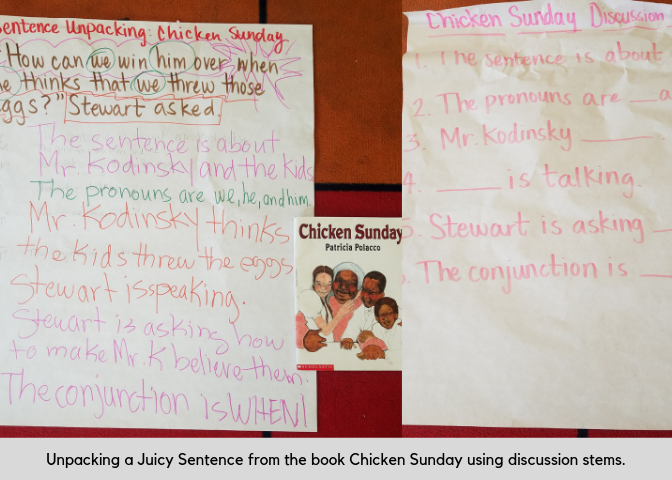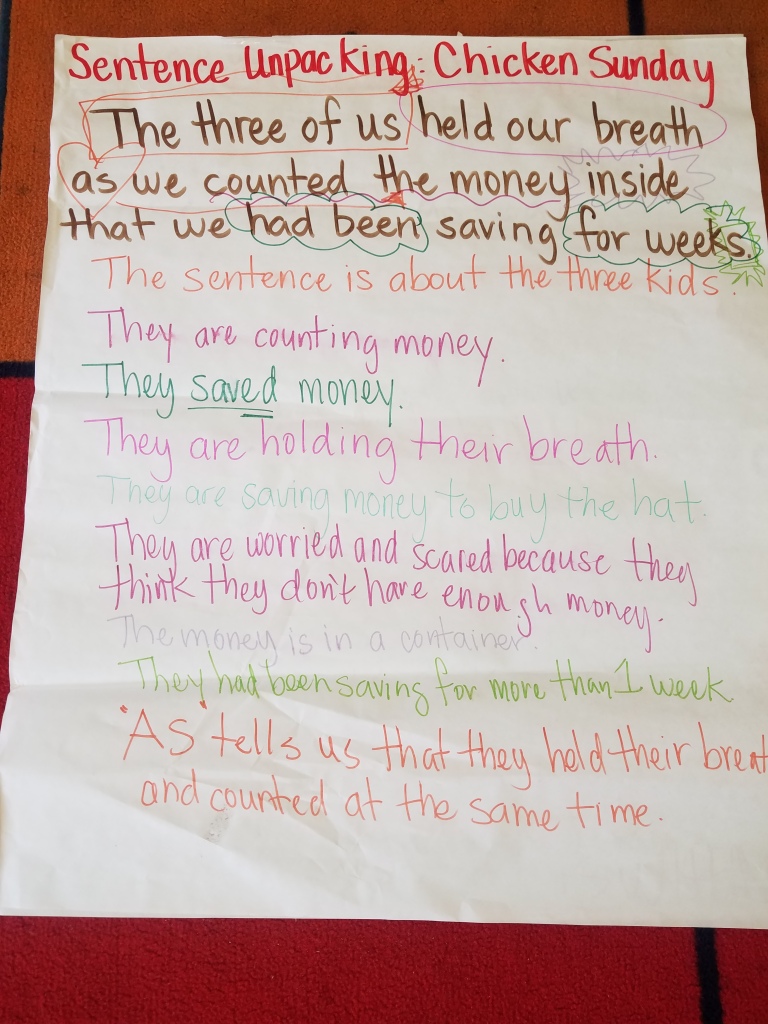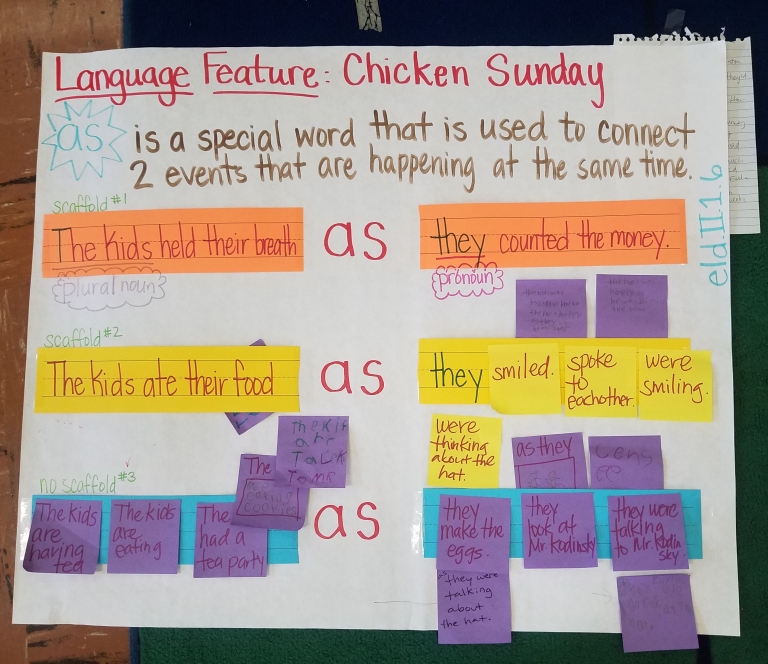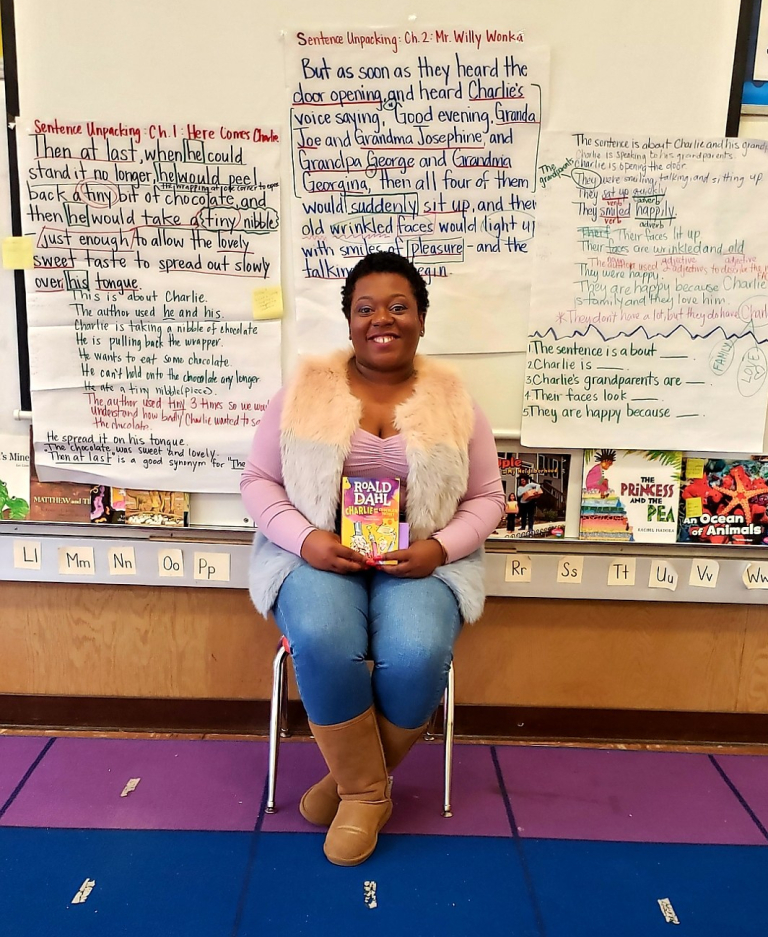A cross post from the amazing folks at the ELLMA office. Ms. Logan McWilliams, known to her students as “Ms. Mac” teaches first grade at Madison Park Lower and is seeing exciting results using Sentence Unpacking for complex text. Thanks to this strategy, her students are not only spontaneously making connections between texts, but are also building a deeper understanding of the way complex language works.
How did you first learn about sentence unpacking as a strategy for your language learners?
Last year, [Elementary Language Specialist] Rita Pope came and did an ELD cycle for us where she introduced several strategies and Sentence Unpacking was one of them. This year in meeting with the ILT, we decided to focus on just one strategy because last year people were overwhelmed with too many options.
Rita came back to do another six week Professional Development cycle just around Sentence Unpacking. All of the teachers first participated in intense learning to get our sea legs with the new content. Then, we moved into classroom implementation and finally rounds of observations and feedback. We’re a very learning-centered school, even for staff.
What would you say you learned?
Once Rita explained Sentence Unpacking, I was immediately in love with it. Some of my biggest takeaways were about the children’s ability to have really high-quality academic conversations about text, and around complex text.
I consider all of my students to be English Language Learners because we’re Early Ed. So they’re all working towards a stronger command of this language, how to read, how to write, whether it’s your native home language or not. It’s been interesting to see more of a level playing field for the native English speakers and the English Language Learners because they’re all working on text that is more complex than their usual reading level. It’s more rigorous for everyone.
Sentence Unpacking allows us to attend to so many features of language and features of language that I don’t realize anymore because I’ve been speaking and reading and writing in English for so long. I was naturally a good reader in school, so there are a lot of features of language that aren’t naturally illuminated for me. Sentence Unpacking brings all of those features to the forefront and really helps me to dig really deep into the rich text that I’m already using in class so that students don’t miss all of this meat.

Have you observed any impact on student’s language and literacy skills?
Definitely. I think the biggest thing I’ve seen with my students is their increased ability to make connections across text. Before, I was always trying to drive, to ask those leading questions where you basically give them the answer. I’m seeing them get there more naturally now.
You don’t do Sentence Unpacking with a new text, so we used several books that we had read prior. I started to hear them have conversations about those texts on their own – when they’re writing, when they’re talking with their friends. I’ll be reading a book they’ve never seen, and they make a reference to the sentences we unpacked from prior text, which I could never get them to do before. Now they do and I completely attribute it to the conversations we had with Sentence Unpacking.
What advice do you have for teachers who are just getting started with Sentence Unpacking?
Plan it out and write out all of your questions and anticipated responses prior to doing the lesson. For your anchor chart, write out the questions that you’re going to ask and what you think they’re going to say, it really helps the flow of the lesson. Plan step by step before you do it. You could just write on your chart in pencil first and then write over it in marker when you’re actually teaching. I would also say, unpack the sentence for yourself first with annotations to make sure that you’ve hit every single aspect. Don’t leave anything packed, unpack every single ounce of it.
The best sentence unpacking lessons I’ve done have been via collaboration with another teacher of the same grade or that is using the same text. So, I partnered with a second grade teacher and we used the same text and the same sentence to plan. Then we did the lesson with our own classrooms and came back together to debrief. It was much easier going into new learning with another teacher, using the same sentence and the same text and not feel like you’re in a silo – you can bounce your questions or feedback off one another. It was also a really great experience to combine classes and have one of us teach, while the other one observes. Then, we would switch…it allowed us to see the strategy on another teacher.
When you’re teaching, definitely use response structures that are equitable. So Turn and Talk, Think-Pair-Share, using Equity Sticks to get everybody talking. You want to get everybody thinking about the text, talking about the text.
Another thing that was really helpful for the younger grades was color-coding the sentence. So if I’m dealing with the subject then when I write down that part of the in purple; now I’m dealing with the predicate so I put that in red; now I’m dealing with a conjunction, put that in brown. Matching the color of the text to the color of the unpacked sentence at the bottom really helped them to transfer back and forth easily.

What’s the gist of the Sentence Unpacking strategy for those who are not familiar?
We do the “unpacking” over three days.
Day One: Introduce the juicy sentence and ask carefully crafted questions to unpack meaning
First, choose a complex text your students are already familiar with. Then choose a “Juicy Sentence” worth unpacking, it has to have a lot of information, a lot of meat. Write the sentence up on the top of an anchor chart, and begin to unpack it. It can be as simple as asking like the five W’s: Who is the sentence about? What are they doing? How are they doing it? When did this happen? However many questions you need to ask to unpack every single aspect of the sentence, you ask them.
Write the questions down in pencil and what you expect the students to say next to it. Another tip: I always make my last question about the language feature that I am going to teach the next day. For example, a conjunction we worked on a lot was “as”. So, if part of the sentence said we huddled together as we counted the money, the last question would be “What conjunction did the author use to show that they huddled at the same time that they counted the money?” I always make that the last thing that they remember from day one.
Day Two: Practice using the focus language feature
On day two, we get into a language feature based on the ELD standards for your grade level. Since I chose the standard about conjunctions, I made an anchor chart where we took both phrases from the Juicy Sentence and showed how the events happened at the same time or one after the other, depending on where the conjunction is. Then I would give an event and, using the same conjunction, students had to come up with another event that would happen at the same time. On the last round, both sides were blank and students have to come up with two events that could happen at the same time. It’s an ‘I do, We do, You do’ type of thing.

Day Three: Put the sentence back together again!
Day three is a re-pack. Let’s say on day one you unpack your original sentence into six simple sentences. On day three, you want to try to re-pack all those simple sentences into as few sentences as possible, preferably one. The idea is to re-pack it, but with a completely re-phrased sentence that doesn’t lose any of the meaning of the original. So you end up with two different sentences, one is the original and the other is in your own words. If they have the same meaning, that’s how you know if students truly comprehended the original sentence.
That sounds challenging!
It is, but it’s a lot a lot of fun. They really enjoy it.
SHARE THIS:
PUBLISHED BY ELLMASPOTLIGHTS
“Language is learned, not because we want to talk or read or write about language, but because we want to talk and read and write about the world.” — Courtney, Cazden, Professor Emerita, Harvard Graduate School of Education. This blog, curated by Oakland Unified School District’s English Language Learner and Multilingual Achievement Office, seeks to spotlight Oakland teachers and the diverse strategies they’ve implemented to support English Language Learners to achieve at high levels and graduate college, career and community ready. We’ll also be showcasing some of our beautiful students along the way to share their dreams and journeys thus far. Do you have a teacher you’d like us to spotlight? Nominate them here!View all posts by ELLMAspotlights

